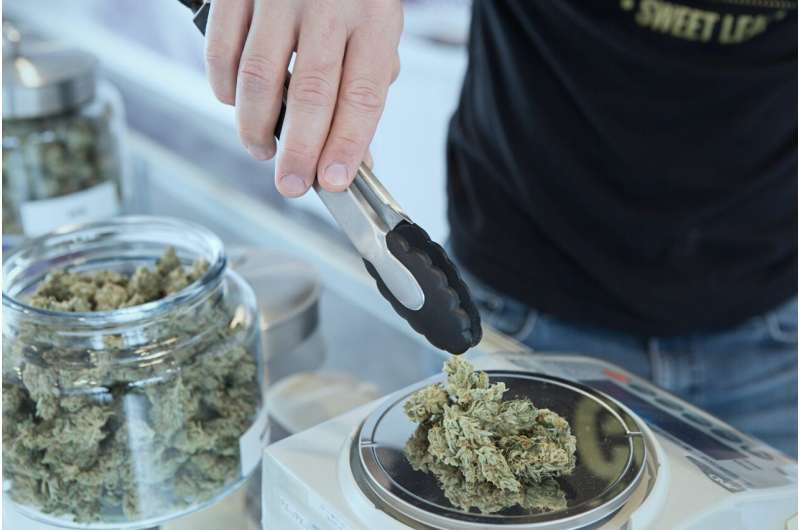This article has been reviewed according to Science X's editorial process and policies. Editors have highlighted the following attributes while ensuring the content's credibility:
fact-checked
trusted source
proofread
Cannabis use found to be lower among Illinois teens living in ZIP codes with medical dispensaries

Illinois teens who live in ZIP codes that have medical cannabis dispensaries are less likely to use the drug, new research found.
In a statewide survey, about 18.3% of the youths living in Illinois ZIP codes with medical dispensaries reported they used cannabis during the prior year compared with 22.4% of those who lived in ZIP codes without these businesses, researchers at the University of Illinois Urbana-Champaign found. They reported the findings in the journal Cannabis.
Likewise, fewer students—12%—with medical dispensaries in their ZIP codes reported they had used cannabis during the prior 30 days, compared with 15.6% of their peers who lived in other ZIP codes, the researchers found.
The sample included more than 10,560 young people who participated in the 2018 Illinois Youth Survey, a biennial assessment conducted by the Center for Prevention Research and Development at the U. of I. The anonymous survey asks students in the eighth, 10th and 12th grades at schools across Illinois about various health and social issues, including their alcohol, tobacco and drug use.
"There's good news, and there are still reasons to be cautious and continue monitoring things," said Doug Smith, the director of the center, a professor of social work and an expert on substance use in teens and young adults. "The good news is that it looks like in Illinois there was no immediate impact on adolescent substance use rates after medical dispensaries came on. In fact, we found that across the whole sample, those who lived in a ZIP code with a dispensary were less likely to have used cannabis during the past 30 days or one year."
The data were collected between January and June 2018. At that time, Illinois had 53 medical cannabis dispensaries in operation. Two additional licenses had been approved but the facilities were not yet open. The study also preceded the state's legalization of recreational cannabis in January 2020.
As to why overall cannabis use was lower among teens living in ZIP codes with dispensaries, Smith said the team was not certain. "It's a head-scratcher to be honest," he said. "The only reason I can think of is that in 2018 there were only 53 dispensaries in operation across the state of Illinois. It could be that the state was just not saturated enough with these facilities to see an effect at that time.
"However, we need to combat the hysteria that legalizing cannabis is going to have a wild and resounding impact on teens in terms of substance use rates and prevalence," Smith said. "That's simply not the case."
The average age of the students surveyed was 15 years old. Most of the students in the sample were white (43%) or Latino (26%).
Consistent with national data, cannabis usage significantly increased as Illinois students progressed from eighth to 12th grade, regardless of whether there was a dispensary in their ZIP code, the researchers found.
Most of those surveyed—47%—were from suburban Chicago, while 21% were from other cities, about 18% lived in rural areas and 14% resided in the city of Chicago.
About 32% of the Chicago youths in the study lived in ZIP codes where medical cannabis dispensaries were operating compared with 3.5% of those living in rural areas.
Cannabis usage was more prevalent in more populated areas, the data indicated. Overall, 29% of students living in the city of Chicago reported they had used cannabis, compared with 19% of those from the Chicago suburbs, 22% of students from other urban areas and 19% of rural students, according to the study.
Smith said the team explored whether ZIP code size in square miles influenced students' awareness of a medical use dispensary and their cannabis usage in turn, since those from geographically larger ZIP codes might be less aware they were living near a dispensary.
While the team found that the average land area within the ZIP codes with dispensaries was smaller than those without them—23.7 and 33.2 square miles, respectively—they did not find a significant correlation between ZIP code size and teens' cannabis use.
"Now that we have medical dispensaries, there are a lot more options, including cannabis-infused beverages, edibles and a whole range of other products. The one we worry the most about with teens—whose brains are still developing—is cannabis concentrates. We are still studying them, but probably the best advice we can give people is to use forms that are less concentrated. That is particularly true for teens.
"Because of these unknowns, it's really important to keep replicating these studies and monitoring some of the newer forms of cannabis, such as the concentrates that contain more of the psychotropic ingredient THC," Smith said.
More information: Douglas Smith et al, Adolescent Cannabis Use Among Youth in ZIP Codes with Medical Dispensaries, Cannabis (2022). DOI: 10.26828/cannabis/2022.03.004





















